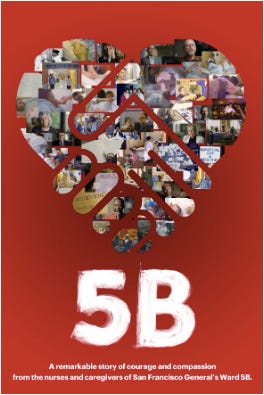How to extend National Hospital Week by another week
Seven eye-opening documentaries show health care across time and space
National Hospital Week officially ended Saturday. Every year it starts on Florence Nightingale’s birthday, May 12th, which is also the last day of National Nurses Week. I love how Nightingale’s legacy overlaps these two important professional recognition weeks.
You can still celebrate National Hospital Week with these seven films. Given the history of National Hospital Week, they show just how far medicine and health care have come.
Take Frederick Wiseman’s “Hospital” for example. Filmed at New York City’s Metropolitan Hospital Center in 1969, his Emmy-winning “Hospital” is the first TV movie to be preserved at the National Film Registry. You can check out his entire catalogue on Kanopy.
“Hospital” also forms part of Wiseman’s medical trilogy including the long-banned “Titicut Follies” and the nearly six hour long “Near Death.” Like all of Wiseman’s films, “Hospital” is completely mesmerizing and only slightly less disturbing than “Titicut Follies.” Here’s the trailer:
Following Wiseman’s illustrious filmmaking 40 years later, Peter Nicks’s 2012 cinéma vérité depiction “The Waiting Room” takes us inside another overcrowded emergency room. This time the camera is firmly planted at Hillside Hospital in Oakland, CA, where the director neither narrates nor interviews a single soul. Watching the health care system unfold from the perspective of the perennially underrated waiting room will captivate you.
I have screened “The Waiting Room” for health care colleagues before. Everyone who sees it comes away with newfound respect for this particular part of every hospital setting. Many astute viewers also note how “The Waiting Room” takes place shortly after the Patient Protection and Affordable Care Act was signed into law, yet somewhat before its full implementation. You can check out “The Waiting Room” on Hulu.
To see another side of Highland Hospital, check out Dan Krauss’s 2016 documentary short “Extremis.” At 24 minutes, this end-of-life look at the ICU reflects what many serious illness conversations include: an observation that time is short. “Extremis” is available on Netflix.
The next two films I recommend are in keeping with National Hospital Week’s origin in 1921. In an effort to foster trust in hospitals after the deadly flu epidemic of 1918-1920, what began as a single day later became a whole week in 1953. And honoring Nightingale’s many innovations in hospital care in the 19th century provides a nice backdrop for 2018’s film “5B” and 2020’s “76 Days.”
The former focuses on the nurses and caregivers who opened Ward 5B at San Francisco General Hospital in 1983 at the dawn of the AIDS epidemic. The latter looks at lockdown in Wuhan, China during the early days of COVID-19; it still gives me chills.
If you ever want to get an inside look at the role of hospital quality and supply chain security, nothing is more shocking than 2019’s “Collective.” The first Romanian film to be nominated for an Academy Award, the story behind “Collective” begins with a fire at a Bucharest nightclub. Twenty-seven people die instantly, while 180 more are injured.
Reader warning: if infected wounds gross you out half as much as they make me ill, proceed with caution. However, “Collective” also shows the power of investigative journalism, not to mention the specialty care of a burn unit. The whole story is an unfathomable tragedy told through a unique angle.
For another totally incredible hospital story, look no farther than Emma Francis-Snyder’s 38 minute op-doc “Takeover.” Like Wiseman’s “Hospital,” this one also takes place in New York City. The year is 1970 and the setting is Lincoln Hospital. I still can’t believe this ever happened.
Finally, if you want to add one more New York City stop, “American Symphony” is the uplifting patient and family perspective you’ve been waiting for. Also on Netflix, it tells the story of contemporary American composer Jon Batiste as his best-selling writer wife Suleika Jaouad undergoes cancer treatment. The music, the love, the dancing in the Memorial Sloan Kettering Cancer Center halls.
It’s not exactly a hospital story, but it’s too good to overlook here. If you haven’t seen it, as Pete Nicks would ask, what are you waiting for?



